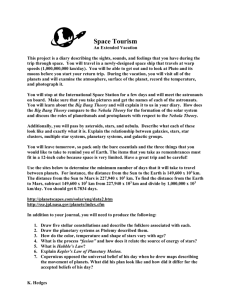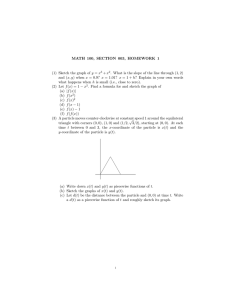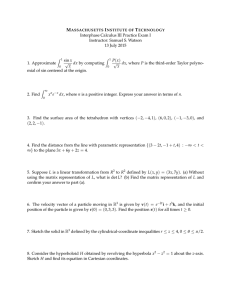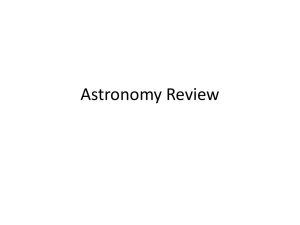Document 13445379
advertisement
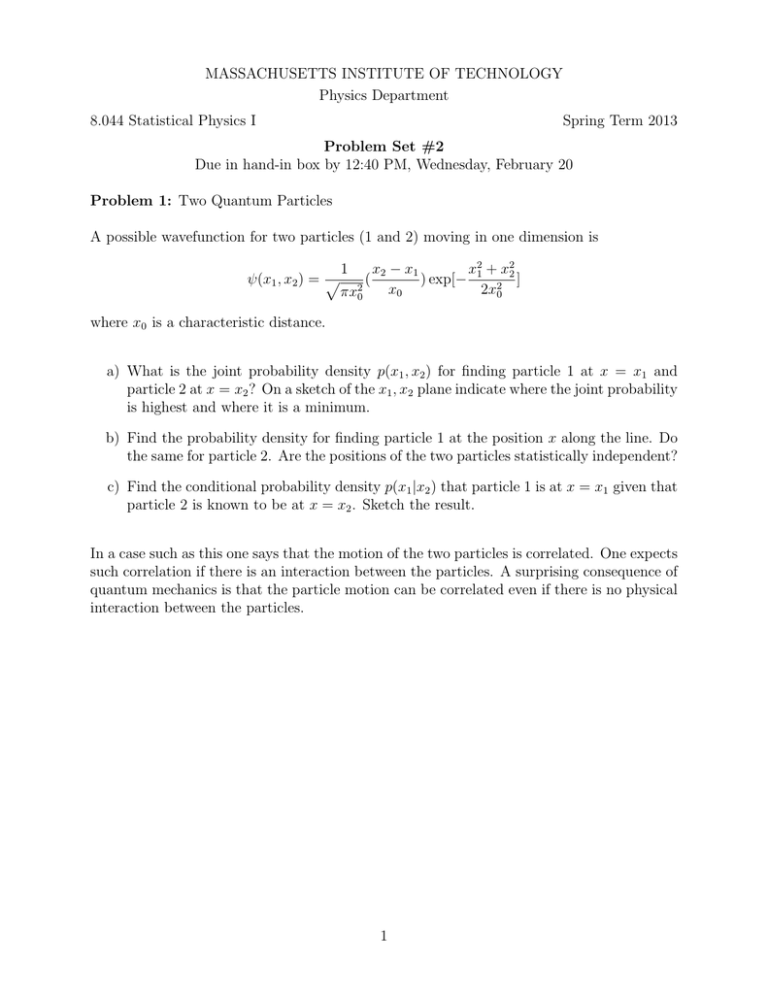
MASSACHUSETTS INSTITUTE OF TECHNOLOGY Physics Department 8.044 Statistical Physics I Spring Term 2013 Problem Set #2 Due in hand-in box by 12:40 PM, Wednesday, February 20 Problem 1: Two Quantum Particles A possible wavefunction for two particles (1 and 2) moving in one dimension is 1 x2 − x1 x2 + x2 ψ(x1 , x2 ) = _ 2 ( ) exp[− 1 2 2 ] x0 2x0 πx0 where x0 is a characteristic distance. a) What is the joint probability density p(x1 , x2 ) for finding particle 1 at x = x1 and particle 2 at x = x2 ? On a sketch of the x1 , x2 plane indicate where the joint probability is highest and where it is a minimum. b) Find the probability density for finding particle 1 at the position x along the line. Do the same for particle 2. Are the positions of the two particles statistically independent? c) Find the conditional probability density p(x1 |x2 ) that particle 1 is at x = x1 given that particle 2 is known to be at x = x2 . Sketch the result. In a case such as this one says that the motion of the two particles is correlated. One expects such correlation if there is an interaction between the particles. A surprising consequence of quantum mechanics is that the particle motion can be correlated even if there is no physical interaction between the particles. 1 Problem 2: Pyramidal Density The joint probability density p(x, y) for two random variables x and y is given below. p(x,y) 6 p(x, y) = 6(1 − x − y) ⎧ ⎨ 0≤x 0≤y if ⎩ x+y ≤1 1 = 0 y othewise 1 x a) Find the probability density p(x) for the random variable x alone. Sketch the result. b) Find the conditional probability density p(y|x). Sketch the result. Problem 3: Stars a) Assume that the stars in a certain region of the galaxy are distributed at random with a mean density ρ stars per (light year)3 . Find the probability density p(r) that a given star’s nearest neighbor occurs at a radial distance r away. [Hint: This is the exact analogue of the waiting time problem for radioactive decay, except that the space is 3 dimensional rather than 1 dimensional.] The acceleration a of a given star due to the gravitational attraction of its neighbors is a= ∞ � GMi i=1 |ari |3 ari where ari is the vector position of the ith neighbor relative to the star in question and Mi is its mass. The terms in the sum fall off rapidly with increasing distance. For some purposes the entire sum can be approximated by its first term, that due to the nearest neighbor. In this approximation GM a ≡ |aa| = 2 r where r is the radial distance to the nearest neighbor and M is its mass. b) Find an expression which relates p(a) to p(r). In what region of p(a) would you expect the greatest error due to the neglect of distant neighbors? 2 c) Next assume that the stars are distributed at random in space with a uniform density ρ. Use the results of a) to find p(a). In astrophysics, this is known as the Holtsmark Distribution. It is known that the assumption of uniformly distributed stars breaks down at short distances due to the occurrence of gravitationally bound complexes (binary stars, etc.). In which region of p(a) would you expect to see deviations from your calculated result due to this effect? d) What other probabilistic aspect of the problem (i.e. what other random variable) would have to be taken into account before our p(a) could be compared with experimental observations? Problem 4: Kinetic Energies in Ideal Gasses For an ideal gas of classical non-interacting atoms in thermal equilibrium the cartesian components of the velocity are statistically independent. In three dimensions 2 −3/2 p(vx , vy , vz ) = (2πσ ) vx2 + vy2 + vz2 exp[− ] 2σ 2 where σ 2 = kT /m. The energy of a given atom is E = 12 m|av |2 . a) Find the probability density for the energy of an atom in the three dimensional gas, p(E). Is it Gaussian? It is possible to create an ideal two dimensional gas. For example, noble gas atoms might be physically adsorbed on a microscopically smooth substrate; they would be bound in the perpendicular direction but free to move parallel to the surface. b) Find p(E) for the two dimensional gas. Is it Gaussian? 3 Problem 5: Measuring an Atomic Velocity Profile d vx s Atoms emerge from a source in a well collimated beam with velocities av = vx x̂ directed horizontally. They have fallen a distance s under the influence of gravity by the time they hit a vertical target located a distance d from the source. s= A vx2 where A = 12 gd2 is a constant. An empirical fit to measurements at the target give the following probability density px (ζ) for an atom striking the target at position s. ps (ζ) = A3/2 1 A √ exp[− 2 ] 5/2 2σ ζ σ 2 2πσ 2 ζ = 0 ζ≥0 ζ<0 Find the probability density pvx (η) for the velocity at the source. Sketch the result. 4 Problem 6: Planetary Nebulae Planetary Nebula Abell 39 Planetary Nebula Shapley 1 Pictures from the archive at Astronomy Picture of the Day http://antwrp.gsfc.nasa.gov/apod/ During stellar evolution, a low mass star in the “red supergiant” phase (when fusion has nearly run its course) may blow off a sizable fraction of its mass in the form of an expanding spherical shell of hot gas. The shell continues to be excited by radiation from the hot star at the center. This glowing shell is referred to by astronomers as a planetary nebula (a historical misnomer) and often appears as a bright ring. We will investigate how a shell becomes a ring. One could equally ask “What is the shadow cast by a semitransparent balloon?” A photograph of a planetary nebula records the amount of matter having a given radial distance r⊥ from the line of sight joining the central star and the observer. Assume that the gas atoms are uniformly distributed over a spherical shell of radius R centered on the parent star. What is the probability density p(r⊥ ) that a given atom will be located a perpendicular distance r⊥ from the line of sight? [Hint: If one uses a spherical coordinate system (r, θ, φ) where θ = 0 indicates the line of sight, then r⊥ = r sin θ. P (r⊥ ) corresponds to that fraction of the sphere with R sin θ < r⊥ .] Note: not all planetary nebula are as well behaved as the two shown above. Visit the Astronomy Picture of the Day and search under planetary nebula to see the unruly but beautiful evolution of most planetary nebulae. 5 MIT OpenCourseWare http://ocw.mit.edu 8.044 Statistical Physics I Spring 2013 For information about citing these materials or our Terms of Use, visit: http://ocw.mit.edu/terms.
